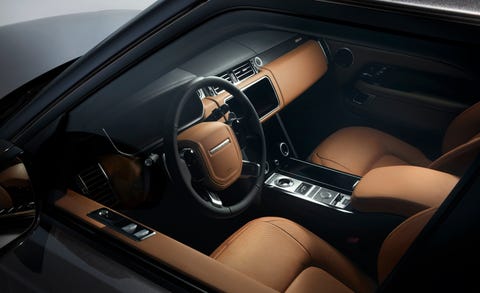2021 Range Rover: Fine leather, real wood trim, plush carpets, and a host of convenient features deck out every one of the Range Rover’s many trims. Lower-end models offer quiet comfort while the high-end SV Autobiography models are a performance pageant headlined by a burbling 557-hp supercharged V-8 engine.
What’s the price for all this sumptuousness? Well, the Range Rover lineup starts just under the six-figure mark, and that’s before you get into the plethora of optional features and customization choices.

Engine, Transmission, and Performance
The 2021 Range Rover has four basic powertrain lineups, each with its own set of strengths and weaknesses: Entry-level models are powered by a turbocharged inline-six that is assisted by a small electric motor for a mild-hybrid setup, while top-of-the-line models feature a raucous supercharged V-8. A diesel V-6 is also available as is a plug-in hybrid.
Every Range Rover comes standard with a selectable all-wheel-drive system and an eight-speed automatic transmission. We don’t have recent test numbers for a Range Rover with the standard inline-six; the diesel Range Rover we tested in 2016 delivered acceptable but relaxed acceleration times. The V-8, on the other hand, delivers shockingly quick acceleration, and even the most committed environmentalists will have to admit it sounds glorious.
Sporty SV Autobiography models do a surprisingly good job of controlling body roll, but fore-aft pitch is a problem across the lineup. It drives well enough if not pressed, but compared for over-the-road agility against high-performance SUVs such as the BMW X5 M and the Mercedes-AMG GLS63, the Land Rover is downright sloppy. We’re willing to forgive some of these handling deficiencies when we consider the Range Rover’s off-road abilities, which remain stellar.
Range, Charging, and Battery Life
The P400e plug-in hybrid powertrain is powered by a 13.1-kWh battery pack located under the rear cargo floor. It can charge on a 120-volt outlet but doing so takes up to 14 hours for a full charge; a 240-volt outlet or trips to a public charging station are recommended.
The EPA says the Range Rover P400e should deliver up to 19 miles of electric driving range per charge.
Fuel Economy and Real-World MPG
Of the 2021 Range Rover’s three gasoline powertrains, only one approaches genuine efficiency, and that’s the diesel which is rated at 22 mpg city and 28 mpg highway. We’ve tested three Range Rovers on our 200-mile real-world highway fuel-economy route.
A 2016 diesel model returned a respectable 27 mpg but still fell 1 mpg short of its EPA rating, while a pair of 2017s with the supercharged V-8 engine returned 19 mpg (long wheelbase) and 20 mpg (regular wheelbase). We haven’t tested the new plug-in hybrid or base inline-six hybrid engines on our fuel-economy route.
Interior, Comfort, and Cargo
Every Range Rover comes standard with leather seats, a heated leather steering wheel, and wood-veneer trim. When you move up into the more expensive versions, that leather is extended to the headliner, the seats add a massaging function, and the carpet that lines the cargo compartment can be swapped for handsomely finished wood.
That’s to say nothing of the metal armrest-adjustment knobs, satin-brushed metal cupholders, and bottle cooler that come in top-of-the-line SV Autobiography models. The Range’s 32 cubic feet of cargo space behind the second row may seem impressive, but it’s surprisingly near the bottom of its segment. Still, it can accommodate 13 carry-on cases when the back seats are in use, which is more than enough for most four- or five-person families.


1 comment
Грандиозный игровой сайт Лев предлагает для вас фантастические шансы для успешной игры!
На площадке Лев вас ожидают удивительные акции и разнообразные игры. Всегда здесь вы успеете выиграть огромные джекпоты с легкостью и удовольствием!
Наше казино предлагает эксклюзивные акции, которые увеличат ваш шанс на победу. Примите участие в игровых мероприятиях, чтобы сорвать куш.
Наш сайт дарит вам эргономичный интерфейс, обеспечивает легкость использования на любом гаджете.
На Лев вас встретят не только настольные игры, но и игры с реальными крупье, которые дадут вам возможность почувствовать себя в настоящем казино из любой точки мира.
Кроме того, наш кэшбэк дадут вам фриспины каждый день.
Играй с удовольствием, побеждай с игровым домом Лев, и завоевывай призов каждый день!
На платформе Лев вас встречают выгодные предложения и разнообразные игры. Только здесь вы получите возможность захватить крупные выигрыши.
Зарегистрируйтесь на платформе Лев и запустите игру игровые автоматы уже сейчас! казино лев, faq, правила, бонус
казино лев 2024